Expanding Continuous Carbon Isotope Measurements of CO2 and CH4 in the Italian ICOS Atmospheric Consortium: First Results from the Continental POT Station in Potenza (Basilicata)
Abstract
1. Introduction
2. The National Consortium, with a Focus on POT
3. Data Gathering and Evaluation Methodology
4. Results
4.1. Observed Values
4.2. Daily Cycle Variability
4.3. Weekly Cycle Variability
4.4. Keeling Plot and Source Apportionment
5. Discussion
6. Conclusions
Author Contributions
Funding
Institutional Review Board Statement
Informed Consent Statement
Data Availability Statement
Acknowledgments
Conflicts of Interest
References
- Craig, H. The geochemistry of the stable carbon isotopes. Geochim. Cosmochim. Acta 1953, 3, 53–92. [Google Scholar] [CrossRef]
- Coplen, T.B. Normalization of oxygen and hydrogen isotope data. Chem. Geol. Isot. Geosci. 1988, 72, 293–297. [Google Scholar] [CrossRef]
- Trumbore, S.E. Carbon respired by terrestrial ecosystems—Recent progress and challenges. Glob. Chang. Biol. 2006, 12, 141–153. [Google Scholar] [CrossRef]
- Etiope, G.; Lassey, K.R.; Klusman, R.W.; Boschi, E. Reappraisal of the fossil methane budget and related emission from geologic sources. Geophys. Res. Lett. 2008, 35, L09307. [Google Scholar] [CrossRef]
- He, Y.; Trumbore, S.E.; Torn, M.S.; Harden, J.W.; Vaughn, L.J.S.; Allison, S.D.; Randerson, J.T. Radiocarbon constraints imply reduced carbon uptake by soils during the 21st century. Science 2016, 353, 1419–1424. [Google Scholar] [CrossRef]
- Yu, M.-Y.; Lin, Y.-C.; Zhang, Y.-L. Estimation of Atmospheric Fossil Fuel CO2 Traced by Δ14C: Current Status and Outlook. Atmosphere 2022, 13, 2131. [Google Scholar] [CrossRef]
- Zazzeri, G.; Graven, H.; Xu, X.; Saboya, E.; Blyth, L.; Manning, A.J.; Chawner, H.; Wu, D.; Hammer, S. Radiocarbon Measurements Reveal Underestimated Fossil CH4 and CO2 Emissions in London. Geophys. Res. Lett. 2023, 50, e2023GL103834. [Google Scholar] [CrossRef]
- Morton, S.G. Synopsis of the organic remains of the Ferruginous Sand Formation of the United States, with geological remarks. Amer. J. Sci. Arts 1830, 18, 243–250. Available online: https://www.biodiversitylibrary.org/page/30953798 (accessed on 30 March 2025).
- d’Orbigny, A.D. Terrains Crétacés. [Cephalopoda]. In Paléontologie Française; L’Auteur: Paris, France, 1840; Volume 1, 662p, Available online: https://www.biodiversitylibrary.org/page/22587199 (accessed on 30 March 2025).
- Craig, H. Isotopic standards for carbon and oxygen and correction factors for mass-spectrometric analysis of carbon dioxide. Geochim. Cosmochim. Acta 1957, 12, 133–149. [Google Scholar] [CrossRef]
- Zazzeri, G.; Lowry, D.; Fisher, R.E.; France, J.L.; Lanoisellé, M.; Grimmond, C.S.B.; Nisbet, E.G. Evaluating methane inventories by isotopic analysis in the London region. Sci. Rep. 2017, 7, 4854. [Google Scholar] [CrossRef]
- Voglar, G.E.; Zavadlav, S.; Levanič, T.; Ferlan, M. Measuring techniques for concentration and stable isotopologues of CO2 in a terrestrial ecosystem: A review. Earth Sci. Rev. 2019, 199, 102978. [Google Scholar] [CrossRef]
- Bowling, D.R.; Pataki, D.E.; Randerson, J.T. Carbon isotopes in terrestrial ecosystem pools and CO2 fluxes. New Phytol. 2008, 178, 24–40. [Google Scholar] [CrossRef]
- Scartazza, A.; Moscatello, S.; Matteucci, G.; Battistelli, A.; Brugnoli, E. Combining stable isotope and carbohydrate analyses in phloem sap and fine roots to study seasonal changes of source-sink relationships in a Mediterranean beech forest. Tree Physiol. 2015, 35, 829–839. [Google Scholar] [CrossRef]
- Becker, M.; Steinhoff, T.; Körtzinger, A. A detailed view of the seasonality of stable carbon isotopes across the North Atlantic. Global Biogeochem. Cycles 2018, 32, 1406–1419. [Google Scholar] [CrossRef]
- Li, C.; Fan, R.; Jiang, W.; Zhang, H.; Li, X.; Chen, F.; Zhang, H. Inter- and Intra-Annual Variations in Oak Tree Ring δ13C Values across Different Elevations and Their Climatic Responses in Qinling Mountains. Atmosphere 2024, 15, 1228. [Google Scholar] [CrossRef]
- Des Marais, D.J.; Moore, J.G. Carbon and its isotopes in mid-oceanic basaltic glasses. Earth Planet. Sci. Lett. 1984, 69, 43–57. [Google Scholar] [CrossRef]
- Deines, P. The carbon isotope geochemistry of mantle xenoliths. Earth Sci. Rev. 2002, 58, 247–278. [Google Scholar] [CrossRef]
- Weissert, H.; Erba, E. Volcanism, CO2 and palaeoclimate: A Late Jurassic-Early Cretaceous carbon and oxygen isotope record. J. Geol. Soc. 2004, 161, 695–702. [Google Scholar] [CrossRef]
- Wan, Z.; Shi, Q.; Guo, F.; Zhong, Y.; Xia, B. Gases in Southern Junggar Basin mud volcanoes: Chemical composition, stable carbon isotopes, and gas origin. J. Nat. Gas Sci. Eng. 2013, 14, 108–115. [Google Scholar] [CrossRef]
- Werner, C.; Fischer, T.P.; Aiuppa, A.; Edmonds, M.; Cardellini, C.; Carn, S.; Chiodini, G.; Cottrell, E.; Burton, M.; Shinohara, H.; et al. Carbon dioxide emissions from subaerial volcanic regions. In Deep Carbon: Past to Present; Orcutt, B.N., Daniel, I., Dasgupta, R., Eds.; Cambridge University Press: Cambridge, UK, 2019; pp. 188–236. [Google Scholar] [CrossRef]
- Peng, Q.; E, C.; Li, X.; Sun, Y.; Zhang, J.; Zhang, S.; Shi, Y.; Ji, X.; Zhang, Z. Holocene Paleoclimate Changes around Qinghai Lake in the Northeastern Qinghai-Tibet Plateau: Insights from Isotope Geochemistry of Aeolian Sediment. Atmosphere 2024, 15, 833. [Google Scholar] [CrossRef]
- Bell, E.A.; Boehnke, P.; Harrison, T.M.; Mao, W.L. Potentially biogenic carbon preserved in a 4.1 billion-year-old zircon. Proc. Natl. Acad. Sci. USA 2015, 112, 14518–14521. [Google Scholar] [CrossRef]
- Graven, H.; Allison, C.E.; Etheridge, D.M.; Hammer, S.; Keeling, R.F.; Levin, I.; Meijer, H.A.J.; Rubino, M.; Tans, P.P.; Trudinger, C.M.; et al. Compiled records of carbon isotopes in atmospheric CO2 for historical simulations in CMIP6. Geosci. Model Dev. 2017, 10, 4405–4417. [Google Scholar] [CrossRef]
- Keeling, C.D.; Mook, W.G.; Tans, P.P. Recent trends in the 13C/12C ratio of atmospheric carbon dioxide. Nature 1979, 277, 121–123. [Google Scholar] [CrossRef]
- Sowers, T.; Bernard, S.; Aballain, O.; Chappellaz, J.; Barnola, J.-M.; Marik, T. Records of the δ13C of atmospheric CH4 over the last 2 centuries as recorded in Antarctic snow and ice. Global Biogeochem. Cycles 2005, 19, GB2002. [Google Scholar] [CrossRef]
- Cao, J.; Chow, J.C.; Tao, J.; Lee, S.; Watson, J.G.; Ho, K.; Wang, G.; Zhu, C.; Han, Y. Stable carbon isotopes in aerosols from Chinese cities: Influence of fossil fuels. Atmos. Environ. 2011, 45, 1359–1363. [Google Scholar] [CrossRef]
- Graven, H.; Keeling, R.F.; Rogelj, J. Changes to carbon isotopes in atmospheric CO2 over the Industrial Era and into the future. Global Biogeochem. Cycles 2020, 34, e2019GB006170. [Google Scholar] [CrossRef] [PubMed]
- Lopez, T.; Aguilera, F.; Tassi, F.; de Moor, J.M.; Bobrowski, N.; Aiuppa, A.; Tamburello, G.; Rizzo, A.L.; Liuzzo, M.; Viveiros, F.; et al. New insights into the magmatic-hydrothermal system and volatile budget of Lastarria volcano, Chile: Integrated results from the 2014 IAVCEI CCVG 12th Volcanic Gas Workshop. Geosphere 2018, 14, 983–1007. [Google Scholar] [CrossRef]
- Yang, W.; Magid, J.; Christensen, S.; Rønn, R.; Ambus, P.; Ekelund, F. Biological 12C-13C fractionation increases with increasing community-complexity in soil microcosms. Soil Biol. Biochem. 2014, 69, 197–201. [Google Scholar] [CrossRef]
- Philben, M.; Bowering, K.; Podrebarac, F.A.; Laganière, J.; Edwards, K.; Ziegler, S.E. Enrichment of 13C with depth in soil organic horizons is not explained by CO2 or DOC losses during decomposition. Geoderma 2022, 424, 116004. [Google Scholar] [CrossRef]
- Keeling, C.D. The concentration and isotopic abundances of carbon dioxide in rural and marine air. Geochim. Cosmochim. Acta 1961, 24, 277–298. [Google Scholar] [CrossRef]
- Kirschke, S.; Bousquet, P.; Ciais, P.; Saunois, M.; Canadell, J.G.; Dlugokencky, E.J.; Bergamaschi, P.; Bergmann, D.; Blake, D.R.; Bruhwiler, L.; et al. Three decades of global methane sources and sinks. Nature Geosci. 2013, 6, 813–823. [Google Scholar] [CrossRef]
- Andres, R.J.; Marland, G.; Boden, T.; Bischof, S. Carbon dioxide emissions from fossil fuel consumption and cement manufacture, 1751–1991, and an estimate of their isotopic composition and latitudinal distribution. In The Carbon Cycle; Wigley, T.M., Schimel, D.S., Eds.; Cambridge University Press: Cambridge, UK, 1991; pp. 53–62. [Google Scholar]
- Widory, D. Combustibles, fuels and their combustion products: A view through carbon isotopes. Combust. Theory Model. 2006, 10, 831–841. [Google Scholar] [CrossRef]
- Pataki, D.E.; Bowling, D.R.; Ehleringer, J.R. Seasonal cycle of carbon dioxide and its isotopic composition in an urban atmosphere: Anthropogenic and biogenic effects. J. Geophys. Res.—Atmos. 2003, 108, 4735. [Google Scholar] [CrossRef]
- Quirk, T.; Asten, M. Atmospheric CO2 Isotopic Variations, with Estimation of Ocean and Plant Source Contributions. Atmosphere 2023, 14, 1623. [Google Scholar] [CrossRef]
- Keeling, C.D.; Whorf, T.P.; Wahlen, M.; van der Plichtt, J. Interannual extremes in the rate of rise of atmospheric carbon dioxide since 1980. Nature 1995, 375, 666–670. [Google Scholar] [CrossRef]
- Ghasemifard, H.; Yuan, Y.; Luepke, M.; Schunk, C.; Chen, J.; Ries, L.; Leuchner, M.; Menzel, A. Atmospheric CO2 and δ13C Measurements from 2012 to 2014 at the Environmental Research Station Schneefernerhaus, Germany: Technical Corrections, Temporal Variations and Trajectory Clustering. Aerosol Air Qual. Res. 2019, 19, 657–670. [Google Scholar] [CrossRef]
- Bezyk, Y.; Górka, M.; Sówka, I.; Nęcki, J.; Strąpoć, D. Temporal dynamics and controlling factors of CO2 and CH4 variability in the urban atmosphere of Wroclaw, Poland. Sci. Total Environ. 2023, 893, 164771. [Google Scholar] [CrossRef]
- Bučinskas, L.; Garbarienė, I.; Mašalaitė, A.; Šapolaitė, J.; Ežerinskis, Ž.; Jasinevičienė, D.; Garbaras, A. Evaluating the Impact of Increased Heavy Oil Consumption on Urban Pollution Levels through Isotope (δ13C, δ34S, 14C) Composition. Atmosphere 2024, 15, 883. [Google Scholar] [CrossRef]
- Lopez, M.; Schmidt, M.; Delmotte, M.; Colomb, A.; Gros, V.; Janssen, C.; Lehman, S.J.; Mondelain, D.; Perrussel, O.; Ramonet, M.; et al. CO, NOx and 13CO2 as tracers for fossil fuel CO2: Results from a pilot study in Paris during winter 2010. Atmos. Chem. Phys. 2013, 13, 7343–7358. [Google Scholar] [CrossRef]
- Clark-Thorne, S.T.; Yapp, C.J. Stable carbon isotope constraints on mixing and mass balance of CO2 in an urban atmosphere: Dallas metropolitan area, Texas, USA. Appl. Geochem. 2003, 18, 75–95. [Google Scholar] [CrossRef]
- Widory, D.; Javoy, M. The carbon isotope composition of atmospheric CO2 in Paris. Earth Planet. Sci. Lett. 2003, 215, 289–298. [Google Scholar] [CrossRef]
- Horsfield, B.; Rullkötter, J. Diagenesis, Catagenesis, and Metagenesis of Organic Matter. In The Petroleum System—From Source to Trap; Magoon, L.B., Dow, W.G., Eds.; American Association of Petroleum Geologists: Tulsa, OK, USA, 1994; Volume 60. [Google Scholar] [CrossRef]
- Nisbet, E.G.; Dlugokencky, E.J.; Manning, M.R.; Lowry, D.; Fisher, R.E.; France, J.L.; Michel, S.E.; Miller, J.B.; White, J.W.C.; Vaughn, B.; et al. Rising atmospheric methane: 2007–2014 growth and isotopic shift. Global Biogeochem. Cycles 2016, 30, 1356–1370. [Google Scholar] [CrossRef]
- Nisbet, E.G.; Manning, M.R.; Dlugokencky, E.J.; Fisher, R.E.; Lowry, D.; Michel, S.E.; Lund Myhre, C.; Platt, S.M.; Allen, G.; Bousquet, P.; et al. Very strong atmospheric methane growth in the 4 years 2014–2017: Implications for the Paris Agreement. Global Biogeochem. Cycles 2019, 33, 318–342. [Google Scholar] [CrossRef]
- Fisher, R.E.; France, J.L.; Lowry, D.; Lanoisellé, M.; Brownlow, R.; Pyle, J.A.; Cain, M.; Warwick, N.; Skiba, U.M.; Drewer, J.; et al. Measurement of the 13C isotopic signature of methane emissions from northern European wetlands. Global Biogeochem. Cycles 2017, 31, 602–623. [Google Scholar] [CrossRef]
- Fujita, R.; Graven, H.; Zazzeri, G.; Hmiel, B.; Petrenko, V.V.; Smith, A.M.; Michel, S.E.; Morimoto, S. Global fossil methane emissions constrained by multi-isotopic atmospheric methane histories. J. Geophys. Res.-Atmos 2025, 130, e2024JD041266. [Google Scholar] [CrossRef]
- Wahlen, M.; Tanaka, N.; Henry, R.; Yoshinari, T. 13C, D and 14C in methane. Eos Trans. AGU 1987, 68, 1220. [Google Scholar]
- Neef, L.; van Weele, M.; van Velthoven, P. Optimal estimation of the present-day global methane budget. Global Biogeochem. Cycles 2010, 24, GB4024. [Google Scholar] [CrossRef]
- Monteil, G.; Houweling, S.; Dlugockenky, E.J.; Maenhout, G.; Vaughn, B.H.; White, J.W.C.; Rockmann, T. Interpreting methane variations in the past two decades using measurements of CH4 mixing ratio and isotopic composition. Atmos. Chem. Phys. 2011, 11, 9141–9153. [Google Scholar] [CrossRef]
- Chanton, J.P.; Rutkowski, C.M.; Schwartz, C.C.; Ward, D.E.; Boring, L. Factors influencing the stable carbon isotopic signature of methane from combustion and biomass burning. J. Geophys. Res. Atmos. 2000, 105, 1867–1877. [Google Scholar] [CrossRef]
- Allan, W.; Lowe, D.C.; Gomez, A.J.; Struthers, H.; Brailsford, G.W. Interannual variation of 13C in tropospheric methane: Implications for a possible atomic chlorine sink in the marine boundary layer. J. Geophys. Res.-Atmos 2005, 110, D11306. [Google Scholar] [CrossRef]
- Basu, S.; Lan, X.; Dlugokencky, E.; Michel, S.; Schwietzke, S.; Miller, J.B.; Bruhwiler, L.; Oh, Y.; Tans, P.P.; Apadula, F.; et al. Estimating emissions of methane consistent with atmospheric measurements of methane and δ13C of methane. Atmos. Chem. Phys. 2022, 22, 15351–15377. [Google Scholar] [CrossRef]
- Umezawa, T.; Machida, T.; Ishijima, K.; Matsueda, H.; Sawa, Y.; Patra, P.K.; Aoki, S.; Nakazawa, T. Carbon and hydrogen isotopic ratios of atmospheric methane in the upper troposphere over the Western Pacific. Atmos. Chem. Phys. 2012, 12, 8095–8113. [Google Scholar] [CrossRef]
- O’Malley, V.P.; Burke, R.A.; Schlotzhauer, W.S. Using GC-MS/Combustion/IRMS to determine the 13C/12C ratios of individual hydrocarbons produced from the combustion of biomass materials-application to biomass burning. Org. Geochem. 1997, 27, 567–581. [Google Scholar] [CrossRef]
- Tittel, F.K.; Weidmann, D.; Oppenheimer, C.; Gianfrani, L. Laser Absorption Spectroscopy for volcano monitoring. Opt. Photonics News 2006, 17, 24–31. [Google Scholar] [CrossRef]
- Fisher, R.E.; Lowry, D.; Wilkin, O.; Sriskantharajah, S.; Nisbet, E.G. High-precision, automated stable isotope analysis of atmospheric methane and carbon dioxide using continuous-flow isotope-ratio mass spectrometry. Rapid Commun. Mass Spectrom. 2006, 20, 200–208. [Google Scholar] [CrossRef]
- Cui, X.; Zhang, Z.; Pang, T.; Xia, H.; Sun, P.; Wu, B.; Yu, R. Development of a stable carbon isotopes analysis instrument based on tunable diode laser absorption spectroscopy. IOP Conf. Ser. Mater. Sci. Eng. 2020, 730, 012005. [Google Scholar] [CrossRef]
- Tuzson, B.; Mohn, J.; Zeeman, M.; Werner, R.A.; Eugster, W.; Zahniser, M.S.; Nelson, D.D.; McManus, J.B.; Emmenegger, L. High precision and continuous field measurements of δ13C and δ18O in carbon dioxide with a cryogen-free QCLAS. Appl. Phys. B 2008, 92, 451–458. [Google Scholar] [CrossRef]
- Eyer, S.; Tuzson, B.; Popa, M.E.; van der Veen, C.; Röckmann, T.; Rothe, M.; Brand, W.A.; Fisher, R.; Lowry, D.; Nisbet, E.G.; et al. Real-time analysis of δ13C- and δD-CH4 in ambient air with laser spectroscopy: Method development and first intercomparison results. Atmos. Meas. Tech. 2016, 9, 263–280. [Google Scholar] [CrossRef]
- Crosson, E.R.; Ricci, K.N.; Richman, B.A.; Chilese, F.C.; Owano, T.G.; Provencal, R.A.; Todd, M.W.; Glasser, J.; Kachanov, A.A.; Paldus, B.A.; et al. Stable isotope ratios using cavity ring-down spectroscopy: Determination of 13C/12C for carbon dioxide in human breath. Anal. Chem. 2002, 74, 2003–2007. [Google Scholar] [CrossRef]
- Maher, D.T.; Santos, I.R.; Tait, D.R. Mapping methane and carbon dioxide concentrations and δ13C values in the atmosphere of two Australian coal seam gas fields. Water Air Soil. Pollut. 2014, 225, 2216. [Google Scholar] [CrossRef]
- Rella, C.W.; Hoffnagle, J.; He, Y.; Tajima, S. Local- and regional-scale measurements of CH4, δ13CH4, and C2H6 in the Uintah Basin using a mobile stable isotope analyzer. Atmos. Meas. Tech. 2015, 8, 4539–4559. [Google Scholar] [CrossRef]
- Dickinson, D.; Bodé, S.; Boeckx, P. System for δ13C-CO2 and xCO2 analysis of discrete gas samples by cavity ring-down spectroscopy. Atmos. Meas. Tech. 2017, 10, 4507–4519. [Google Scholar] [CrossRef]
- Sprenger, M.; Tetzlaff, D.; Soulsby, C. No influence of CO2 on stable isotope analyses of soil waters with off-axis integrated cavity output spectroscopy (OA-ICOS). Rapid Commun. Mass Spectrom. 2017, 31, 430–436. [Google Scholar] [CrossRef] [PubMed]
- Griffith, D.W.T.; Deutscher, N.M.; Caldow, C.; Kettlewell, G.; Riggenbach, M.; Hammer, S. A Fourier transform infrared trace gas and isotope analyser for atmospheric applications. Atmos. Meas. Tech. 2012, 5, 2481–2498. [Google Scholar] [CrossRef]
- Rizzo, A.L.; Liuzzo, M.; Ancellin, M.A.; Jost, H.J. Real-time measurements of δ13C, CO2 concentration, and CO2/SO2 in volcanic plume gases at Mount Etna, Italy, over 5 consecutive days. Chem. Geol. 2015, 411, 182–191. [Google Scholar] [CrossRef]
- Lapenna, E.; Buono, A.; Mauceri, A.; Zaccardo, I.; Cardellicchio, F.; D’Amico, F.; Laurita, T.; Amodio, D.; Colangelo, C.; Di Fiore, G.; et al. ICOS Potenza (Italy) atmospheric station: A new spot for the observation of greenhouse gases in the Mediterranean basin. Atmosphere 2025, 16, 57. [Google Scholar] [CrossRef]
- Villalobos, Y.; Gómez-Ortiz, C.; Scholze, M.; Monteil, G.; Karstens, U.; Fiore, A.; Brunner, D.; Thanwerdas, J.; Cristofanelli, P. Towards improving top-down national CO2 estimation in Europe: Potential from expanding the ICOS atmospheric network in Italy. Environ. Res. Lett. 2025, 20, 054002. [Google Scholar] [CrossRef]
- Keeling, C.D. The concentration and isotopic abundances of atmospheric carbon dioxide in rural areas. Geochim. Cosmochim. Acta 1958, 13, 322–334. [Google Scholar] [CrossRef]
- Calidonna, C.R.; D’Amico, F.; Ammoscato, I.; Malacaria, L.; Gulli, D.; Lo Feudo, T.; Sinopoli, S.; De Benedetto, G.; Mona, L.; Dema, C.; et al. Continuous δ13C-CO2 and δ13C-CH4 Measurements in the Atmosphere—Data Gathered at Lamezia Terme (Calabria, Southern Italy) Between July and December 2024. Version 1. Available online: https://hub.itineris.cnr.it/datasets/ (accessed on 30 March 2025).
- National Research Council of Italy—Institute of Methodologies for Environmental Analysis. CNR-IMAA Atmospheric Observatory (CIAO). Available online: https://ciao.imaa.cnr.it (accessed on 31 May 2025).
- Laurita, T.; Mauceri, A.; Cardellicchio, F.; Lapenna, E.; De Rosa, B.; Trippetta, S.; Mytilinaios, M.; Amodio, D.; Giunta, A.; Ripepi, E.; et al. CIAO observatory main upgrade: Building up an ACTRIS compliant aerosol in-situ laboratory. Atmos. Meas. Tech. 2025, 18, 2373–2396. [Google Scholar] [CrossRef]
- Heiskanen, J.; Brümmer, C.; Buchmann, N.; Calfapietra, C.; Chen, H.; Gielen, B.; Gkritzalis, T.; Hammer, S.; Hartman, S.; Herbst, M.; et al. The Integrated Carbon Observation System in Europe. Bull. Am. Meterol. Soc. 2022, 103, E855–E872. [Google Scholar] [CrossRef]
- Laj, P.; Myhre, C.L.; Riffault, V.; Amiridis, V.; Fuchs, H.; Eleftheriadis, K.; Petäjä, T.; Salameh, T.; Kivekäs, N.; Juurola, E.; et al. Aerosol, Clouds and Trace Gases Infrastructure (ACTRIS); The European Research Infrastructure Supporting Atmospheric Science. B. Am. Meteor. Soc. 2024, 105, E1098–E1136. [Google Scholar] [CrossRef]
- Adame, J.A.; Padilla, R.; Gutierrez-Alvarez, I.; Bogeat, J.A.; Lopez, A.; Yela, M. Greenhouse gases in the tall tower of El Arenosillo station in Southwestern Europe: First-year of measurements. Atmos. Res. 2024, 299, 107221. [Google Scholar] [CrossRef]
- Röckmann, T.; Eyer, S.; van der Veen, C.; Popa, M.E.; Tuzson, B.; Monteil, G.; Houweling, S.; Harris, E.; Brunner, D.; Fischer, H.; et al. In situ observations of the isotopic composition of methane at the Cabauw tall tower site. Atmos. Chem. Phys. 2016, 16, 10469–10487. [Google Scholar] [CrossRef]
- Storm, I. ICOS Atmospheric Stations: Spatial Characterization of CO2 Footprint Areas and Evaluating the Uncertainties of Modelled CO2 Concentrations. Master’s Thesis, Lund University, Lund, Sweden, 2020. [Google Scholar]
- Storm, I.; Karstens, U.; D’Onofrio, C.; Vermeulen, A.; Peters, W. A view of the European carbon flux landscape through the lens of the ICOS atmospheric observation network. Atmos. Chem. Phys. 2023, 23, 4993–5008. [Google Scholar] [CrossRef]
- Buono, A.; Zaccardo, I.; D’Amico, F.; Mona, L.; Ripepi, E.; Dema, C. Continuous δ13C-CO2 and δ13C-CH4 measurements in the atmosphere—Data gathered at Potenza (Basilicata, Southern Italy) in 2025. Version 1 . Available online: https://hub.itineris.cnr.it/datasets/ (accessed on 25 June 2025).
- Hoheisel, A.; Yeman, C.; Dinger, F.; Eckhardt, H.; Schmidt, M. An improved method for mobile characterisation of δ13CH4 source signatures and its application in Germany. Atmos. Meas. Tech. 2019, 12, 1123–1139. [Google Scholar] [CrossRef]
- Picarro. G2201-i Analyzer User Manual for Isotopic CO2/CH4. Available online: https://www.picarro.com/environmental/g2201i_analyzer_user_manual_for_isotopic_CO2_CH4 (accessed on 5 February 2025).
- Altman, D.G.; Bland, J.M. Measurement in Medicine: The Analysis of Method Comparison Studies. J. R. Stat. Soc. D 1983, 32, 307–317. [Google Scholar] [CrossRef]
- Bland, J.M.; Altman, D.G. Statistical methods for assessing agreement between two methods of clinical measurement. Lancet 1986, 327, 307–310. [Google Scholar] [CrossRef]
- Datta, D. blandr: Bland-Altman Method Comparison Package for R, version 0.6.0; Zenodo: Geneva, Switzerland, 2024. [Google Scholar] [CrossRef]
- International Atomic Energy Agency (IAEA). IAEA-TECDOC-2066—Measurement of the Stable Carbon Isotope Ratio in Atmospheric CH4 Using Laser Spectroscopy for CH4 Source Characterization; IAEA: Vienna, Austria, 2024. [Google Scholar] [CrossRef]
- D’Amico, F.; Ammoscato, I.; Gullì, D.; Avolio, E.; Lo Feudo, T.; De Pino, M.; Cristofanelli, P.; Malacaria, L.; Parise, D.; Sinopoli, S.; et al. Integrated analysis of methane cycles and trends at the WMO/GAW station of Lamezia Terme (Calabria, Southern Italy). Atmosphere 2024, 15, 946. [Google Scholar] [CrossRef]
- D’Amico, F.; Ammoscato, I.; Gullì, D.; Avolio, E.; Lo Feudo, T.; De Pino, M.; Cristofanelli, P.; Malacaria, L.; Parise, D.; Sinopoli, S.; et al. Anthropic-induced variability of greenhouse gasses and aerosols at the WMO/GAW coastal site of Lamezia Terme (Calabria, Southern Italy): Towards a new method to assess the weekly distribution of gathered data. Sustainability 2024, 16, 8175. [Google Scholar] [CrossRef]
- Belikov, D.; Arshinov, M.; Belan, B.; Davydov, D.; Fofonov, A.; Sasakawa, M.; Machida, T. Analysis of the Diurnal, Weekly, and Seasonal Cycles and Annual Trends in Atmospheric CO2 and CH4 at Tower Network in Siberia from 2005 to 2016. Atmosphere 2019, 10, 689. [Google Scholar] [CrossRef]
- Peccarrisi, D.; Romano, S.; Fragola, M.; Buccolieri, A.; Quarta, G.; Calcagnile, L. New insights from seasonal and weekly evolutions of aerosol absorption properties and their association with PM2.5 and NO2 concentrations at a central Mediterranean site. Atmos. Pollut. Res. 2024, 15, 102131. [Google Scholar] [CrossRef]
- Kruskal, W.H.; Wallis, W.A. Use of Ranks in One-Criterion Variance Analysis. J. Am. Stat. Assoc. 1952, 47, 583–621. [Google Scholar] [CrossRef]
- Shapiro, S.S.; Wilk, M.B. An Analysis of Variance Test for Normality (Complete Samples). Biometrika 1965, 52, 591–611. [Google Scholar] [CrossRef]
- Hoheisel, A.; Schmidt, M. Six years of continuous carbon isotope composition measurements of methane in Heidelberg (Germany)—A study of source contributions and comparison to emission inventories. Atmos. Chem. Phys. 2024, 24, 2951–2969. [Google Scholar] [CrossRef]
- Nisbet, E.G.; Fisher, R.E.; Lowry, D.; France, J.L.; Allen, G.; Bakkaloglu, S.; Broderick, T.J.; Cain, M.; Coleman, M.; Fernandez, J.; et al. Methane mitigation: Methods to reduce emissions, on the path to the Paris Agreement. Rev. Geophys. 2020, 58, e2019RG000675. [Google Scholar] [CrossRef]
- Tyler, S.C.; Ajie, H.O.; Gupta, M.L.; Cicerone, R.J.; Blake, D.R.; Dlugokencky, E.J. Stable carbon isotopic composition of atmospheric methane: A comparison of surface level and free tropospheric air. J. Geophys. Res.-Atmos 1999, 104, 13895–13910. [Google Scholar] [CrossRef]
- Zaccardo, I.; Buono, A.; D’Amico, F.; Laurita, T.; Amodio, D.; Cardellicchio, F.; Colangelo, C.; De Rosa, B.; Di Fiore, G.; Gargano, G.; et al. Stable carbon isotope shifts in CO2 and CH4 during Saharan dust intrusions: Insights from CIAO observatory, Southern Italy. Under review.
- Copernicus Aerosol Alerts. Available online: https://aerosol-alerts.atmosphere.copernicus.eu/?date=2025-03-15&lat=16.028464282037497&lon=16.611328125¶meter=od550dust&coords=[[40.41,15.3],[40.82,15.3],[40.82,16.41],[40.41,16.41]]&zoom=4&height=9776000&base_layer=none&overlays=null&view=2d (accessed on 30 March 2025).
- Berezina, E.; Vasileva, A.; Moiseenko, K.; Pankratova, N.; Skorokhod, A.; Belikov, I.; Belousov, V. Atmospheric CH4 and Its Isotopic Composition (δ13C) in Urban Environment in the Example of Moscow, Russia. Atmosphere 2023, 14, 830. [Google Scholar] [CrossRef]
- Lin, X.; Peng, S.; Ciais, P.; Hauglustaine, D.; Lan, X.; Liu, G.; Ramonet, M.; Xi, Y.; Yin, Y.; Zhang, Z.; et al. Recent methane surges reveal heightened emissions from tropical inundated areas. Nat. Commun. 2024, 15, 10894. [Google Scholar] [CrossRef] [PubMed]
- Saueressig, G.; Bergamaschi, P.; Crowley, J.N.; Fischer, H.; Harris, G.W. Carbon kinetic isotope effect in the reaction of CH4 with Cl atoms. J. Geophys. Res.-Atmos. 1995, 22, 1225–1228. [Google Scholar] [CrossRef]
- Lan, X.; Nisbet, E.G.; Dlugokencky, E.J.; Michel, S.E. Improved Constraints on Global Methane Emissions and Sinks Using δ13C-CH4. J. Geophys. Res.-Atmos. 2021, 35, e2021GB007000. [Google Scholar] [CrossRef]
- van Herpen, M.M.J.W.; Li, Q.; Saiz-Lopez, A.; Liisberg, J.B.; Röckmann, T.; Cuevas, C.A.; Fernandez, R.P.; Mak, J.E.; Mahowald, N.M.; Hess, P.; et al. Photocatalytic chlorine atom production on mineral dust–sea spray aerosols over the North Atlantic. Proc. Natl. Acad. Sci. USA 2023, 120, e2303974120. [Google Scholar] [CrossRef]
- Arimoto, R. Eolian dust and climate: Relationships to sources, tropospheric chemistry, transport and deposition. Earth Sci. Rev. 2001, 54, 29–42. [Google Scholar] [CrossRef]
- Bergamaschi, P.; Brühl, C.; Brenninkmeijer, C.A.M.; Saueressig, G.; Crowley, J.N.; Grooß, J.U.; Fischer, H.; Crutzen, P.J. Implications of the large carbon kinetic isotope effect in the reaction CH4 + Cl for the 13C/12C ratio of stratospheric CH4. Geophys. Res. Lett. 1996, 23, 2227–2230. [Google Scholar] [CrossRef]
- Tyler, S.C.; Ajie, H.O.; Rice, A.L.; Cicerone, R.J.; Tuazon, E.C. Experimentally determined kinetic isotope effects in the reaction of CH4 with Cl: Implications for atmospheric CH4. Geophys. Res. Lett. 2000, 27, 1715–1718. [Google Scholar] [CrossRef]
- Artuso, F.; Chamard, P.; Piacentino, S.; di Sarra, A.G.; Meloni, D.; Monteleone, F.; Sferlazzo, D.M.; Thiery, F. Atmospheric methane in the Mediterranean: Analysis of measurements at the island of Lampedusa during 1995–2005. Atmos. Environ. 2007, 41, 3877–3888. [Google Scholar] [CrossRef]
- D’Amico, F.; Lo Feudo, T.; Gullì, D.; Ammoscato, I.; De Pino, M.; Malacaria, L.; Sinopoli, S.; De Benedetto, G.; Calidonna, C.R. Investigation of carbon monoxide, carbon dioxide, and methane source variability at the WMO/GAW station of Lamezia Terme (Calabria, Southern Italy) using the ratio of ozone to nitrogen oxides as a proximity indicator. Atmosphere 2025, 16, 251. [Google Scholar] [CrossRef]
- Ghasemifard, H.; Vogel, F.R.; Yuan, Y.; Luepke, M.; Chen, J.; Ries, L.; Leuchner, M.; Schunk, C.; Noreen Vardag, S.; Menzel, A. Pollution Events at the High-Altitude Mountain Site Zugspitze-Schneefernerhaus (2670 m a.s.l.), Germany. Atmosphere 2019, 10, 330. [Google Scholar] [CrossRef]
- He, L.; Rosa, L.; Lobell, D.B.; Wang, Y.; Yin, Y.; Doughty, R.; Yao, Y.; Berry, J.A.; Frankenberg, C. The weekly cycle of photosynthesis in Europe reveals the negative impact of particulate pollution on ecosystem productivity. Proc. Natl. Acad. Sci. USA 2023, 120, e2306507120. [Google Scholar] [CrossRef]
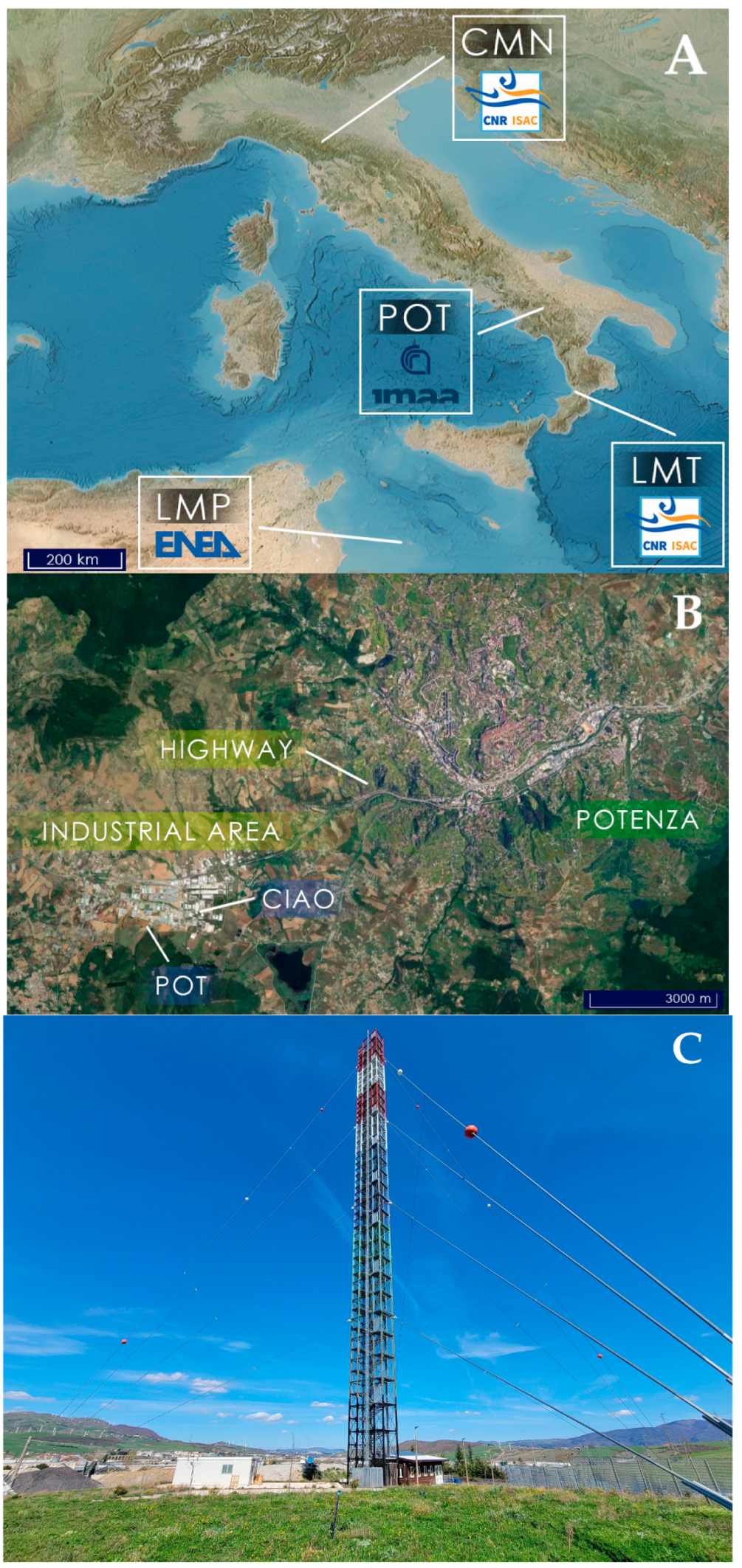


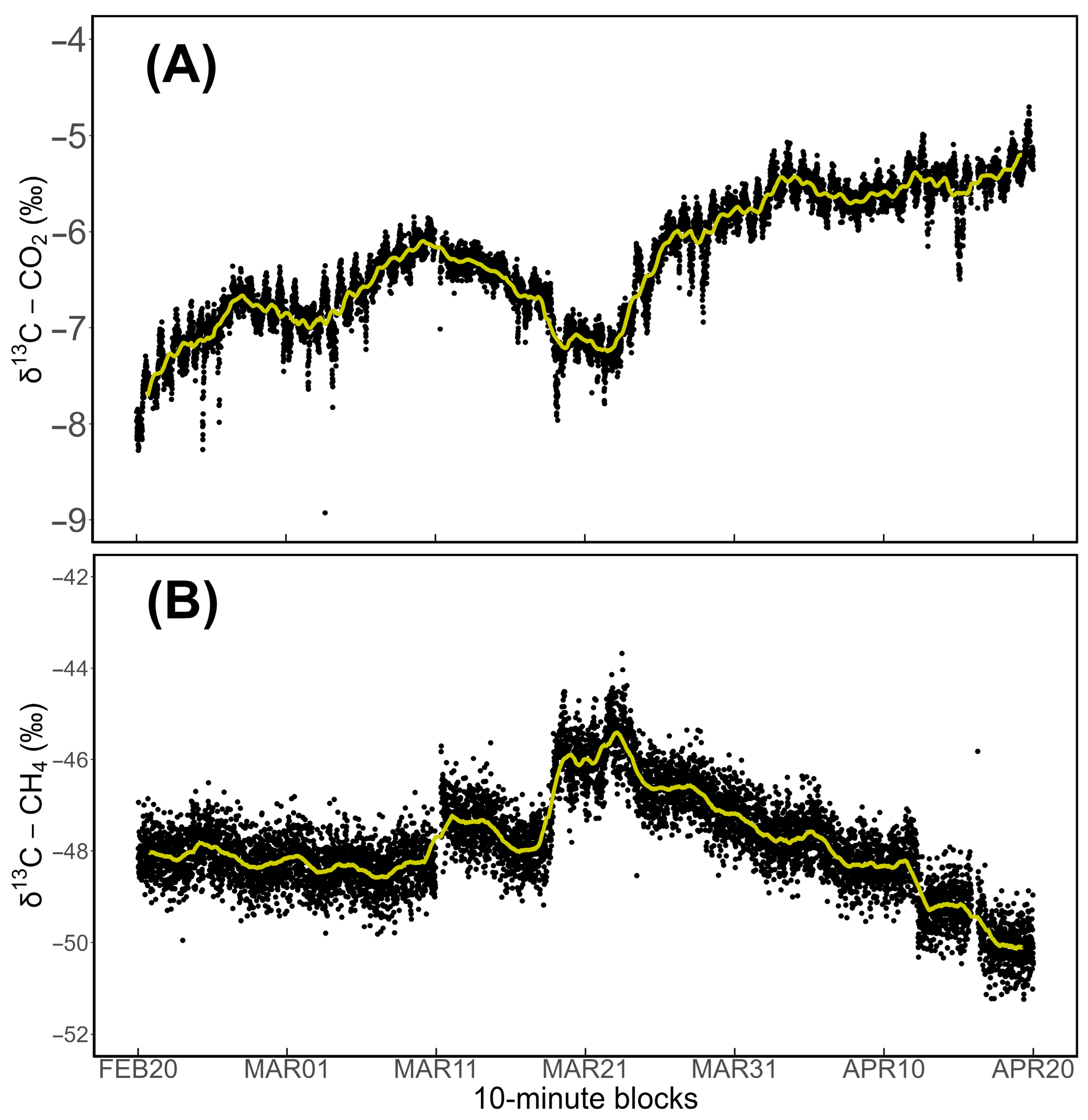
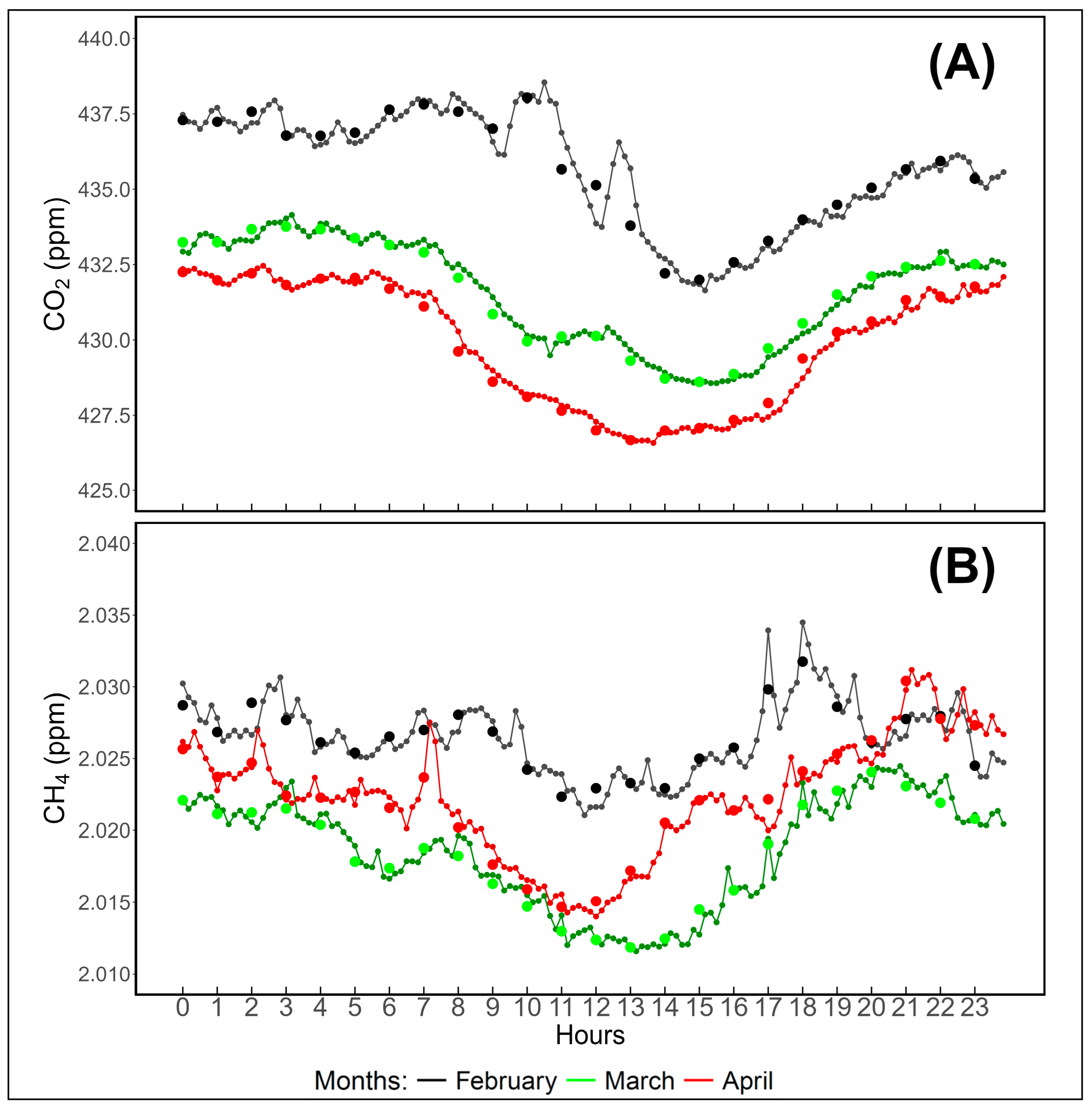
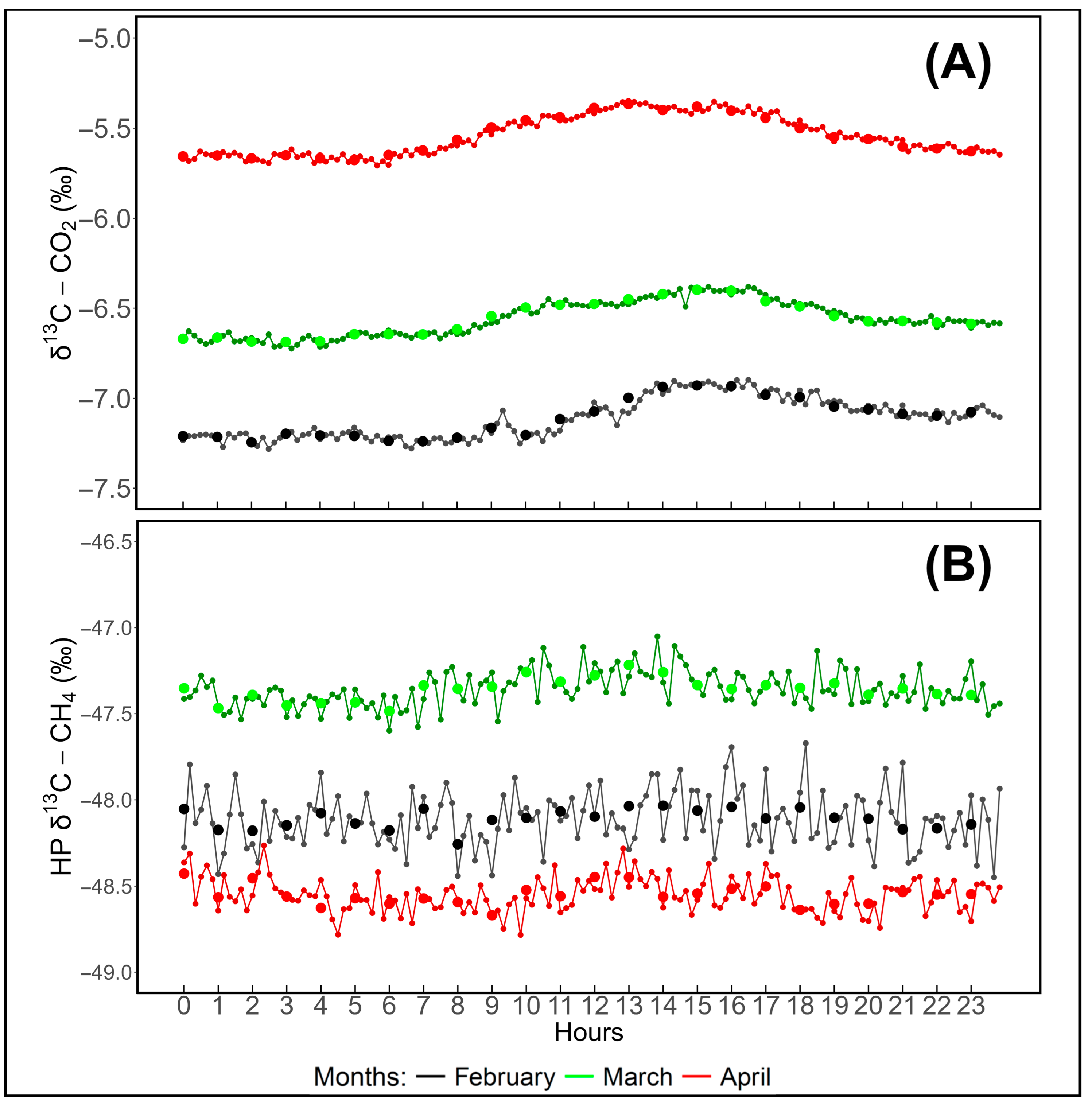
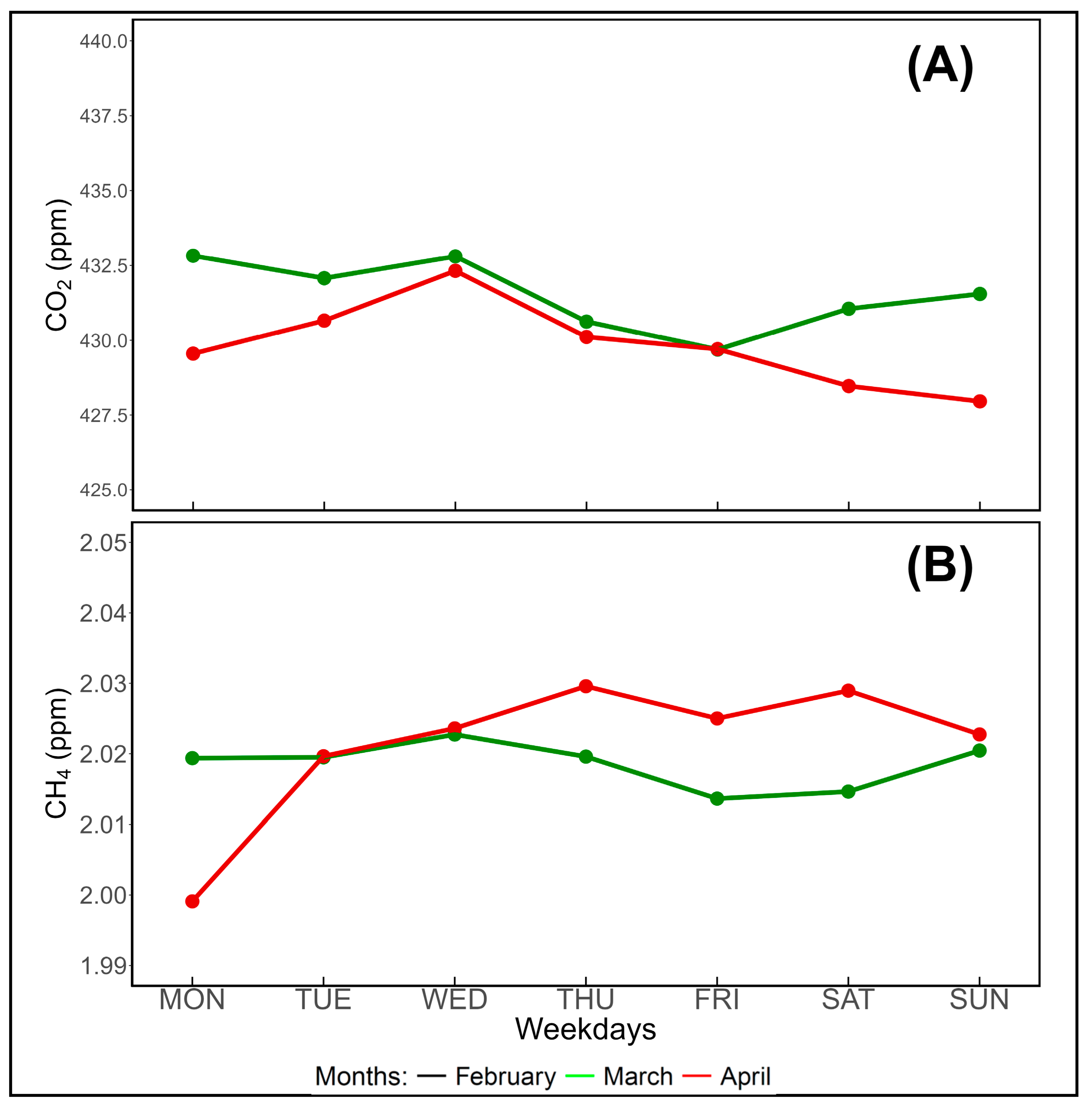

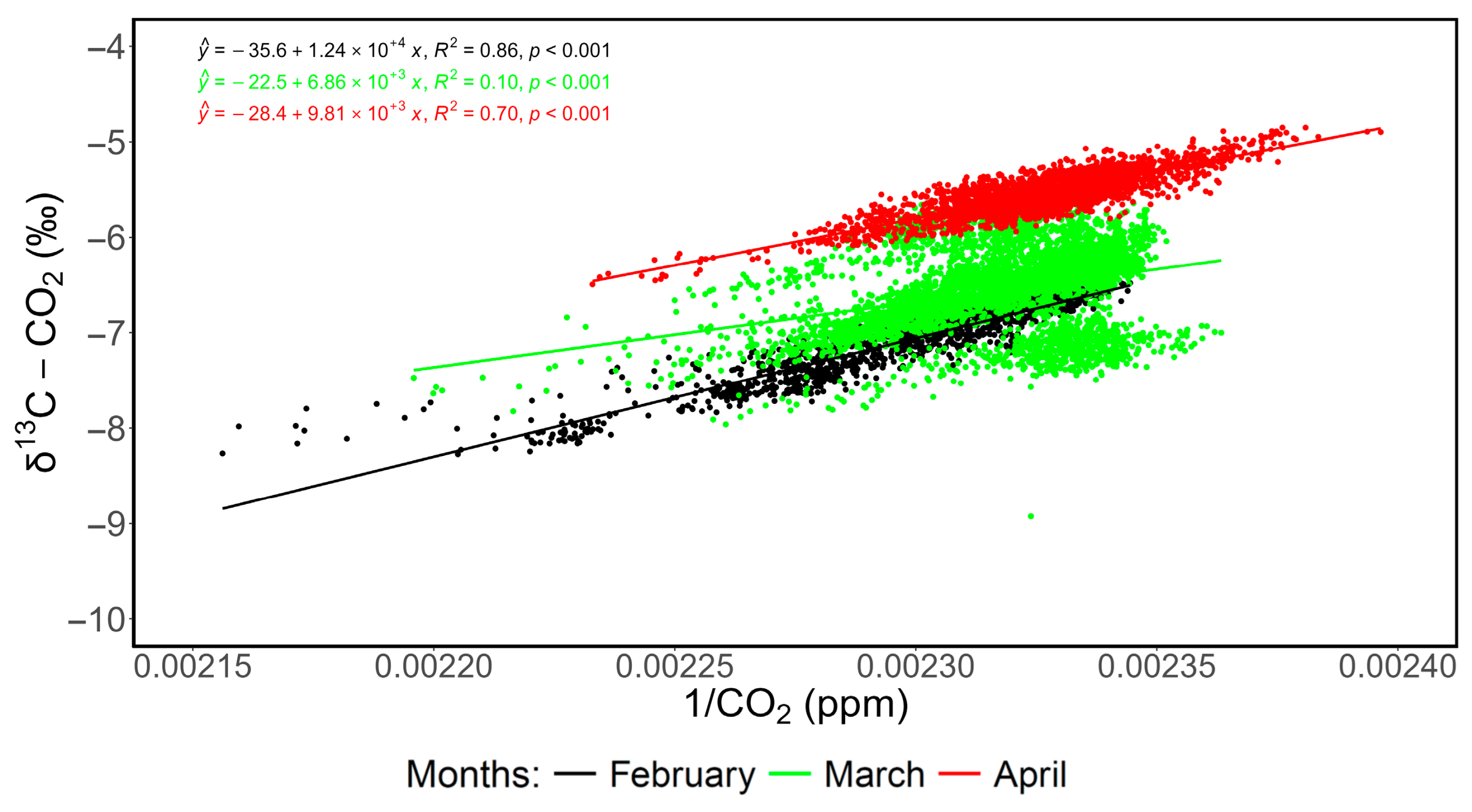
| Statistics | CO2 | CH4 |
|---|---|---|
| Max. Means | 446.36 | 2.08 |
| Min. Means | 420.45 | 1.96 |
| Max. Difference | 35.63 | 0.13 |
| Min. Difference | −16.21 | −0.08 |
| Bias | 1.71 | −0.00 (5) |
| Bias std. dev. | 3.20 | 0.00 (9) |
| Bias up 95% CI | 1.93 | −0.00 (4) |
| Bias low 95% CI | 1.48 | −0.00 (5) |
| Month | CO2 | CH4 | ||
|---|---|---|---|---|
| Conc. (ppm) | δ13C (‰) | Conc. (ppm) | δ13C (‰) | |
| February | 435.65 ± 5.58 | −7.11 ± 0.39 | 2.03 ± 0.02 | −48.11 ± 0.47 |
| March | 431.53 ± 3.91 | −6.56 ± 0.44 | 2.02 ± 0.02 | −47.36 ± 1.06 |
| April | 429.82 ± 3.47 | −5.54 ± 0.22 | 2.02 ± 0.02 | −48.55 ± 1.00 |
Disclaimer/Publisher’s Note: The statements, opinions and data contained in all publications are solely those of the individual author(s) and contributor(s) and not of MDPI and/or the editor(s). MDPI and/or the editor(s) disclaim responsibility for any injury to people or property resulting from any ideas, methods, instructions or products referred to in the content. |
© 2025 by the authors. Licensee MDPI, Basel, Switzerland. This article is an open access article distributed under the terms and conditions of the Creative Commons Attribution (CC BY) license (https://creativecommons.org/licenses/by/4.0/).
Share and Cite
Buono, A.; Zaccardo, I.; D’Amico, F.; Lapenna, E.; Cardellicchio, F.; Laurita, T.; Amodio, D.; Colangelo, C.; Di Fiore, G.; Giunta, A.; et al. Expanding Continuous Carbon Isotope Measurements of CO2 and CH4 in the Italian ICOS Atmospheric Consortium: First Results from the Continental POT Station in Potenza (Basilicata). Atmosphere 2025, 16, 951. https://doi.org/10.3390/atmos16080951
Buono A, Zaccardo I, D’Amico F, Lapenna E, Cardellicchio F, Laurita T, Amodio D, Colangelo C, Di Fiore G, Giunta A, et al. Expanding Continuous Carbon Isotope Measurements of CO2 and CH4 in the Italian ICOS Atmospheric Consortium: First Results from the Continental POT Station in Potenza (Basilicata). Atmosphere. 2025; 16(8):951. https://doi.org/10.3390/atmos16080951
Chicago/Turabian StyleBuono, Antonella, Isabella Zaccardo, Francesco D’Amico, Emilio Lapenna, Francesco Cardellicchio, Teresa Laurita, Davide Amodio, Canio Colangelo, Gianluca Di Fiore, Aldo Giunta, and et al. 2025. "Expanding Continuous Carbon Isotope Measurements of CO2 and CH4 in the Italian ICOS Atmospheric Consortium: First Results from the Continental POT Station in Potenza (Basilicata)" Atmosphere 16, no. 8: 951. https://doi.org/10.3390/atmos16080951
APA StyleBuono, A., Zaccardo, I., D’Amico, F., Lapenna, E., Cardellicchio, F., Laurita, T., Amodio, D., Colangelo, C., Di Fiore, G., Giunta, A., Volini, M., Calidonna, C. R., di Sarra, A. G., Trippetta, S., & Mona, L. (2025). Expanding Continuous Carbon Isotope Measurements of CO2 and CH4 in the Italian ICOS Atmospheric Consortium: First Results from the Continental POT Station in Potenza (Basilicata). Atmosphere, 16(8), 951. https://doi.org/10.3390/atmos16080951









